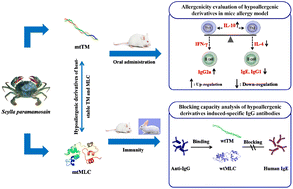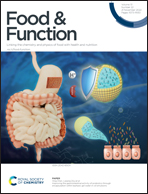Hypoallergenic derivatives of Scylla paramamosain heat-stable allergens alleviated food allergy symptoms in Balb/c mice†
Abstract
The design of hypoallergenic derivatives is a new strategy for allergen-specific immunotherapy. Although hypoallergenic derivatives of Scylla paramamosain (mud crab) heat-stable tropomyosin (TM) and myosin light chain (MLC) have been preliminarily explored, their allergenicity in vivo needs to be further studied. In this work, recombinant allergens (wtTM, wtMLC) and hypoallergenic derivatives (mtTM, mtMLC) were purified. IgE-binding frequencies of wtTM and wtMLC in 177 crab-sensitised patients were 32.8% and 11.9%, respectively. In the Balb/c mouse model, mtTM and mtMLC caused mild intestinal inflammation, did not activate T-helper (Th) 2 immune response (interleukin-4, anaphylactic mediator, IgE, and IgG1 antibodies were not significantly increased) but could significantly promote the production of interleukin-10, which equilibrated Th1/Th2 cells, thus alleviating allergic symptoms. Moreover, mtTM and mtMLC-induced rabbit/mice anti-IgG antibodies could effectively block wtTM and wtMLC binding to patients’ sera IgE in vitro. These results indicate that hypoallergenic derivatives offer the promise for an immunotherapeutic regimen for crab allergy.

- This article is part of the themed collection: Food & Function HOT Articles 2022


 Please wait while we load your content...
Please wait while we load your content...